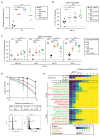Escherichia coli limits Salmonella Typhimurium infections after diet shifts and fat-mediated microbiota perturbation in mice
- PMID: 31591555
- PMCID: PMC6881180
- DOI: 10.1038/s41564-019-0568-5
Escherichia coli limits Salmonella Typhimurium infections after diet shifts and fat-mediated microbiota perturbation in mice
Abstract
The microbiota confers colonization resistance, which blocks Salmonella gut colonization1. As diet affects microbiota composition, we studied whether food composition shifts enhance susceptibility to infection. Shifting mice to diets with reduced fibre or elevated fat content for 24 h boosted Salmonella Typhimurium or Escherichia coli gut colonization and plasmid transfer. Here, we studied the effect of dietary fat. Colonization resistance was restored within 48 h of return to maintenance diet. Salmonella gut colonization was also boosted by two oral doses of oleic acid or bile salts. These pathogen blooms required Salmonella's AcrAB/TolC-dependent bile resistance. Our data indicate that fat-elicited bile promoted Salmonella gut colonization. Both E. coli and Salmonella show much higher bile resistance than the microbiota. Correspondingly, competitive E. coli can be protective in the fat-challenged gut. Diet shifts and fat-elicited bile promote S. Typhimurium gut infections in mice lacking E. coli in their microbiota. This mouse model may be useful for studying pathogen-microbiota-host interactions, the protective effect of E. coli, to analyse the spread of resistance plasmids and assess the impact of food components on the infection process.
Conflict of interest statement
The authors declare no competing financial interests.
Figures




References
Publication types
MeSH terms
Substances
Grants and funding
LinkOut - more resources
Full Text Sources
Other Literature Sources
Medical
Research Materials

